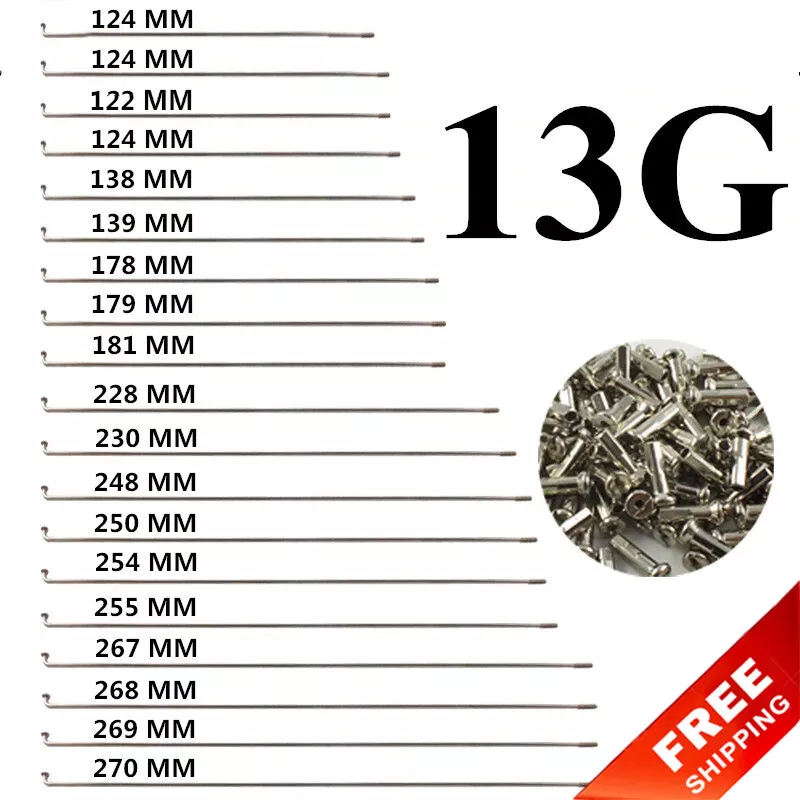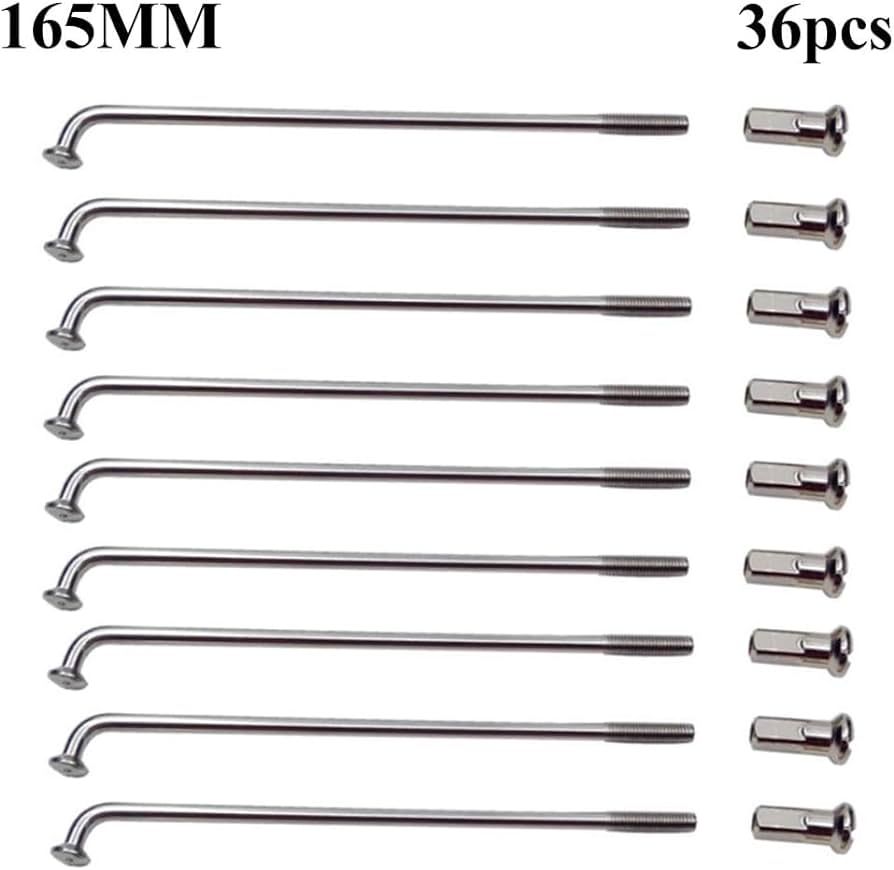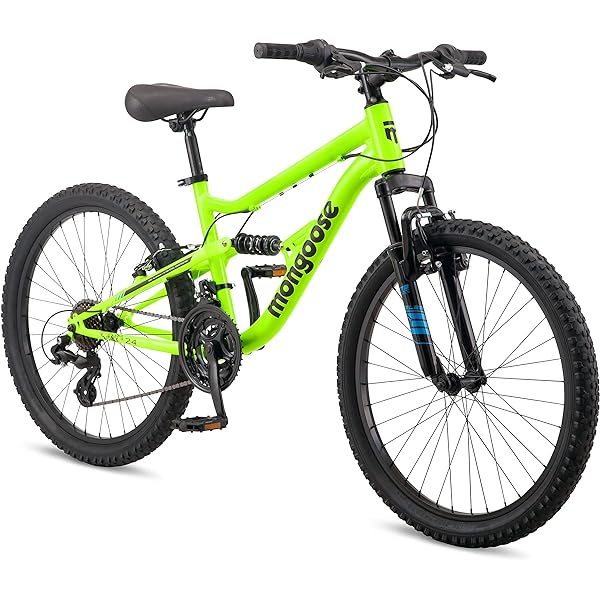Bicycle spokes typically range from 14 to 18 gauge in thickness and 254mm to 310mm in length. The correct size ensures optimal performance and safety.
Choosing the right bicycle spoke size is crucial for maintaining the integrity and performance of your bike. Spokes come in various lengths and thicknesses, each suited for different types of wheels and riding conditions.
Thicker spokes (lower gauge numbers) provide more strength and are ideal for heavy-duty use, while thinner spokes (higher gauge numbers) are lighter and suitable for racing bikes.
Measuring your wheel’s diameter and hub flange distance accurately helps determine the correct spoke length. Properly sized spokes ensure balanced tension, which enhances the wheel’s durability and stability during rides.

Credit: wheelbuilder.com
Introduction To Bicycle Wheel Dynamics
Spokes are crucial in a bicycle wheel. They connect the rim to the hub. This makes the wheel sturdy and balanced. The number of spokes can affect performance. Fewer spokes mean a lighter wheel. More spokes add strength and durability.
The Role Of Spokes In Wheel Performance
Spokes help distribute weight. They also absorb shocks from the road. This makes the ride smoother. Spokes can be made from different materials. Common ones are steel and aluminum. Each material has its own benefits. For example, steel is strong. Aluminum is light.
Bicycle Wheel Anatomy
The wheel has several parts. These include the rim, hub, and spokes. The rim holds the tire. The hub is at the center. Spokes connect the rim to the hub. Each part plays a vital role. Together, they make the wheel work well.
Types Of Bicycle Spokes
Spokes come in different materials. The most common are steel, aluminum, and carbon fiber. Steel spokes are strong and durable. They are also the heaviest.
Aluminum spokes are lighter but can bend easily. Carbon fiber spokes are the lightest. They are also the most expensive. Each material has its own benefits.
Spokes also come in different shapes. Some are round, while others are flat. Flat spokes reduce air resistance. This makes the bike go faster. Round spokes are easier to make. They are also cheaper. The design of the spoke affects the bike’s performance.
Determining The Right Spoke Size
Measuring the rim diameter is crucial for finding the right spoke size. Use a ruler or a tape measure. Measure from one end of the rim to the other. Make sure to measure in millimeters. Write down this measurement. This will help in your calculations.
Calculating spoke length involves a simple formula. You need three measurements: rim diameter, hub flange diameter, and spoke hole circle diameter.
Use a spoke length calculator online. Enter your measurements. The calculator will give you the correct spoke length. This ensures that your spokes fit perfectly.

Credit: www.aliexpress.com
Impact Of Spoke Size On Riding Experience
Shorter spokes make the wheel stronger. The wheel will be less likely to bend. Longer spokes are more flexible. They can absorb bumps better.
But they might make the wheel weaker. Choosing the right spoke size is important for safety. Small spokes can handle more weight. Big spokes are good for comfort.
Thin spokes cut through the air better. This helps you go faster. Thicker spokes create more drag. This can slow you down. Race bikes often use thin spokes.
Mountain bikes use thicker ones. The size of the spoke affects your speed. It also affects how hard you have to pedal. Choose spoke size based on your riding style.
Selecting Spokes For Different Cycling Disciplines
Choosing the right spokes is vital. Lightweight spokes are essential for road biking. They help in achieving higher speeds. Stainless steel spokes are a popular choice. They are both light and strong. Aero spokes can reduce wind resistance.
This helps in maintaining speed. Spoke count typically ranges from 18 to 24 for road bikes. Fewer spokes mean less weight and better aerodynamics.
Spokes for mountain bikes need to be extra durable. Thicker spokes are preferred for rough terrains. Double-butted spokes offer strength and flexibility. These spokes handle impacts better.
Spoke count for mountain bikes usually ranges from 28 to 36. More spokes provide better support. Stainless steel is a common material for mountain bike spokes. They resist rust and are strong. Brass nipples are also recommended. They hold up well under stress.
Installation Tips For Optimal Spoke Tension
Start by inserting spokes into the hub. Make sure they are evenly spaced. Next, thread each spoke into the rim. Tighten them lightly to hold in place. Use a spoke wrench to adjust tension.
Turn each spoke a quarter turn at a time. This helps keep tension even. Check tension using a tension meter. It should match the recommended level.
Uniform tension is crucial for wheel performance. Begin by tightening all spokes to a similar level. Spin the wheel to check for wobbles. Adjust spoke tension to correct any wobbles. Keep checking with a tension meter.
Consistent tension prevents wheel damage. Repeat the process until all spokes have equal tension. This ensures a strong, balanced wheel.
Maintenance And Troubleshooting
Spokes need regular care to work well. Check your spokes every month. Clean them with a soft cloth. Tighten loose spokes with a spoke wrench. Replace broken spokes right away. Inspect your wheel after every long ride. Listen for any clicking sounds.
Bent spokes are a common problem. Straighten them with a spoke tool. Loose spokes can make your wheel wobbly. Tighten them to fix it.
Broken spokes need replacement. Always carry extra spokes and a wrench. Check for rust and clean it off.

Credit: www.ebay.com
Advanced Topics In Spoke Technology
New spoke designs are changing the way bicycles perform. Aerodynamic spokes reduce wind resistance. Lightweight materials make bicycles faster and easier to ride. Carbon fiber spokes are strong and light.
They help in high-speed cycling. Manufacturers are also using 3D printing to create custom spoke shapes. This allows for more personalized designs.
Custom spokes offer unique benefits. Cycling enthusiasts can choose the exact length and material. This ensures a perfect fit for their bike. Custom colors make a bike stand out. Specialized spoke patterns can improve performance.
Handmade spokes are also available for those who want the best quality. Custom spoke solutions are ideal for those who want a unique and high-performing bike.
Frequently Asked Questions
How Do I Know What Size Spokes I Need?
Measure the hub flange distance and the rim’s effective diameter. Use a spoke length calculator for precise size.
What Size Spokes For A 26 Inch Wheel?
Spoke size for a 26-inch wheel typically ranges from 254mm to 262mm. Measure your hub and rim for precision.
What Are The Diameters Of Bicycle Spokes?
Bicycle spokes typically have diameters ranging from 1. 8mm to 2. 3mm. Common sizes include 1. 8mm, 2. 0mm, and 2. 3mm.
What Does 14g Spokes Mean?
14G spokes refer to bicycle spokes with a 2. 0mm thickness. They are common in many bike wheels for their strength.
What Are Common Bicycle Spoke Sizes?
Common bicycle spoke sizes range from 254mm to 310mm. The size depends on the wheel and hub design.
Conclusion
Choosing the right bicycle spoke size is crucial for a smooth ride. It ensures optimal performance and safety.
Take the time to measure accurately and consult experts if needed. Properly sized spokes contribute to the longevity of your bike. Happy cycling!

Steven is a professional cyclist and his passion is cycling. He has been cycling for the last 6 years and he loves using bikes while outing as well. Based on his experiences with the different types of bikes; he is sharing his opinions about various bikes so that a beginner can start right away. Find him on Twitter @thecyclistguy Happy Biking.




Leave a Reply